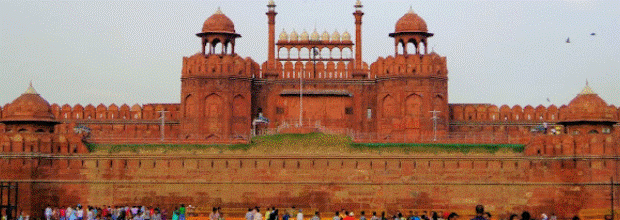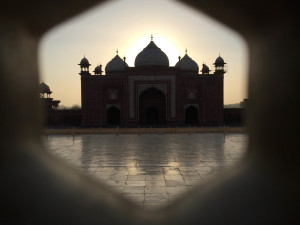 My visit to India last month took place under a set of somewhat frenzied circumstances—getting my passport in order, obtaining a visa (a word to the wise: start as soon as possible)—but as it turned out, the most critical factor in my trip turned out to be someone I had never met: a tour agent based in Delhi by the name of Nitin Shorawal, a man whose career in the travel industry goes back 14 years. He agreed to help me set up an itinerary for my visit to India, including suitable accommodations and professionally accredited tour guides, most of them specializing in history or archaeology, or both.
My visit to India last month took place under a set of somewhat frenzied circumstances—getting my passport in order, obtaining a visa (a word to the wise: start as soon as possible)—but as it turned out, the most critical factor in my trip turned out to be someone I had never met: a tour agent based in Delhi by the name of Nitin Shorawal, a man whose career in the travel industry goes back 14 years. He agreed to help me set up an itinerary for my visit to India, including suitable accommodations and professionally accredited tour guides, most of them specializing in history or archaeology, or both.
The company he currently works for, The Art of Travel, is located in Delhi and was only founded little more than a year ago. No matter how young the company, Mr. Shorawal has clearly brought his many years of experience working for such industry giants as TUI and Kuoni Travel Group (founded 1906).
Our trip quite naturally began in Delhi, an incredibly crowded but nevertheless exciting city of nearly 18 million people. Whatever Delhi’s reputation for being home to the world’s worst traffic jams, nothing can quite compare to the free-for- all that is truly the real thing. Bring your camera, yes, but hang on to it! Such niceties as “yield” signs, red or green lights, intersections, crosswalks, speed limits, or any limits on horn honking simply do not exist in many of India’s cities. Seen primarily by rickshaw, the jams are both terrifying and undeniably exhilarating—worth a visit unto themselves.
Our next stop was a visit to Qutub Minar, a 239-ft. victory tower (India’s highest), built in 1193 by Qutab-ud-din Aibak immediately after the defeat of Delhi’s last Hindu kingdom. It is an impressive structure, and a UNESCO World Heritage Site.
Nightlife in Delhi is quite lively and goes late into the night. There are an abundance of restaurants and street stands available for visitors to choose from. The usual rule of “don’t drink anything that doesn’t come from a sealed bottle” applies, but I had no problem eating food from a number of the vendors along the way.
After a relatively short flight from Delhi, our trip then moved on to Varanasi, one of the seven holiest cities in India, and one of its oldest. It is known not only for its fine-quality silk saris but also for its famous bathing ghats—steps leading down to the banks of the Ganges, the holiest river in India. In the evening, one of the most spectacular sights in Varanasi takes place: the nightly Aarti [“light”] Ganga prayer ceremony that involves lots of fire, candles and lights, torches, incenses and smoke by burning various ingredients.
It is at dawn the following morning, however, that one can witness a truly awesome sight: the beginning of the day on the banks of the Ganges, before the sun has even risen. On the steps of the mighty river—and shortly thereafter in a small rowboat—there are dozens of sights to behold at once: swimmers cooling off before the heat of the day begins to rise; people washing laundry against huge rocks jutting above the river; fisherman pushing their rowboats out to the bay; on land, a group of people surrounding a pit in which the remains of a family member are being cremated; groups of young men in “school” reciting prayers while studying for the monkhood—all this against the backdrop of a breathtaking set of huge buildings, many of them thousands of years old, overlooking the entire scene, and you’re a part of it. Not to be missed.
Another very special site less than 10 miles from Varanasi is the Dhamekh Stupa Senath, one of the four holy places associated with the life of Lord Buddha. Located in a deer park, this holy site dates back to the third century to the twelfth century A.D. The structure sits in close proximity to other sites of interest, including Mulagandha Kuti, the remnant of a huge temple which probably represented the spot where Lord Bhudda used to sit in meditation.
A visit to a local silk-making factory can also be fascinating, especially for people wondering where all those pashmina scarves come from. The ones made in the silk factories in Varanasi are of extremely high quality, usually composed of silk and cashmere.
By car, we wended our way to Agra, a town whose reputation rests primarily on one huge site: the Taj Mahal. For all the pictures you have inevitably seen, for every movie that may have included this magnificent structure in its scenes, nothing can quite compare with walking through a road at the entrance to the compound surrounding the palace, then through one of the four “gates” surrounding the building, and then finally—at the end of a long waterway bordered on either side by small trees—arriving at the object of such admiration, so many travel fantasies, and an object of astonishing beauty and grace: the Taj Mahal. Our visit took place at dawn (the best time to see so much in India), and with every rising degree of the rising sun, the palace changed from tawny shades of blue, to pink, to yellow, and finally to the blindingly pure white with which we have all been accustomed to seeing. Many of the great architectural sights in the world—the Eiffel Tower, the Statue of Liberty, the Tower of London—pale, maybe just a little, when compared to this unique monument of elegance and class.
Less than two miles away, Agra is also home to the deeply impressive Red Fort, a UNESCO World Heritage Site. Commissioned by Shah Jahan, the fifth Mughai Emperor of India, in 1638, the enormous, red sandstone fort was originally built of red brick, with the first mention of it taking place in 1080 A.D. Over the course of the next 400 years, however, the fort was transformed into the glorious red sandstone structure we see today. A tour of the inside of the Red Fort reveals some astonishing red sandstone pillars, intricately sculpted inside and out, and a tranquil water pool.
There’s also the beauty of Jodhbai’s Palace, home to the daughter of Mota Raja Udasingh of Jodpur and wife to Akbar’s son Jehangir. It is a gorgeous, double-storied structure composed of rooms arranged around a large, open-air courtyard. The palace appears to be enormous when seen from the exterior but is actually a relatively intimate family residence when seen from within.
Our next stop, Jaipur, brought us to one of the more beautiful and unusual sights this reporter has ever seen: the Monkey Palace, a compound of buildings located high up in the mountains at the end of a long dirt road. Located in Rajasthan (about six miles away from Jaipur), the site comprises several temples and sacred water tanks in which pilgrims bathe. Built within a mountain pass nestled in the Avaralli Hills, the temple has been a retreat for Hindu ascetics since the early 1500s. The main Temple of Gaitaji is built in pastel pink and features a number of pavilions with rounded roofs, carved pillars and painted walls. The complex is set around a natural spring and waterfalls that create two-tiered pools, an upper and lower one, used for bathing by pilgrims.
True to its name, the real astonishment of the monkey palace is its dozens of tame monkeys, who run and scamper throughout the trees, the buildings, the streets, and visitors, this reporter being one. Although they can occasionally behave quite aggressively—especially toward each other—basically they are not dangerous and, it must be said, almost unbearably cute. It’s a memory that is quite unforgettable and utterly unique in the world. Bring a bag of peanuts, and a couple of bananas—you’ll be glad you did.
Another architecturally stunning site can be seen in the village of Abhaneri, about 60 miles from Jaipur. Chand Baori, the world’s largest stepwell, was built in 800 A.D. It is one of the oldest and most frequently visited landmarks in Jajasthan. The state of Rajastan is extremely arid, and the design and final structure of Chand Baori was intended to conserve as much water as possible. Thirteen stories deep and lined along with walls with double flights of narrow steps arranged in perfect symmetry, it leads down to a rather murky looking wading pool. There may be nothing like this in the world, so don’t miss it.
Yet another of the great architectural monuments we visited in Jaipur (though there are many more to see) is the massive Amer Fort, located in Amer, about six miles from Jaipur. Known for its gorgeous artistic style of Hindu elements, with large ramparts, series of gates and cobbled paths, the fort overlooks the Maota Lake, with formal gardens jutting out over the water. Visitors to the fort number at least 5,000 visitors a day. Looking at the fort from the bottom of a large hill is somewhat akin to viewing the seemingly endless stretch of the Great Wall of China.
And last but not least was the pictorially perfect sight of Jal Mahal (meaning “Water Palace”), a palace located in the middle of Man Sagar Lake in Jaipur city. The palace was renovated in the 18th century by Maharaja Jai Singh II of Amber. Entry to the Water Palace is not allowed, but the sight of it from afar is incredibly lovely to behold.
Our final destination was Mumbai, a huge, cosmopolitan city of twelve and half million people. One of the highlights of our visit to Mumbai was to the “world’s largest commercial laundry,” where, each day, 3,000 men, each in their own cubicle, clean laundry (outside) by banging the clothes or outfits on wet stone from morning to night. It’s an incredible sight, and a testament (of sorts) to man’s capacity to work even under the most difficult of circumstances. There are many faces to Mumbai—some of the richest real estate in the world, some of the greatest poverty, elegant beachfront hotels and homeless people sleeping on the beach. In certain ways Mumbai is an almost classic portrait of today’s India—a tale not of two cities but of dozens, an amazing, kaleidoscopic place to visit, a place where being helped by a private guide can make the difference between a perfect trip and a disappointing one.
Nitin Shorawal and The Art of Travel possess both the expertise of 15 years in the travel business but also have a keen feel for the needs and wishes of the clients they serve. Whether your preference is for historical sites, or events taking place in the country’s largest cities, or the serenity of the Himalayan Mountains, Mr. Shorawal is a genial, knowledgeable and helpful tour agent whose participation in your travels throughout India will leave you with a bounty of happy memories.
The Art of Travel, www.artoftravel.co.in
Places to stay:
Crowne Plaza, Delhi, www.crowneplaza.com/newdelhirohini
Varanasi: Hotel Clarks, Varanasi, www.clarkshotels.com
Agra: Mansingh Palace Agra, www.mansinghhotels.com/agra
Jaipur: Le Meridien Jaipur, Rajastan, www.starwoodhotels.com/lemeridien
Mumbai: The Emerald, www.theemerald.com
Juhu Tara Road, 011-91-22-6714 4000





